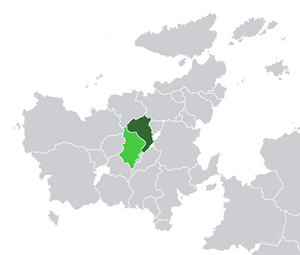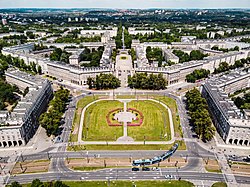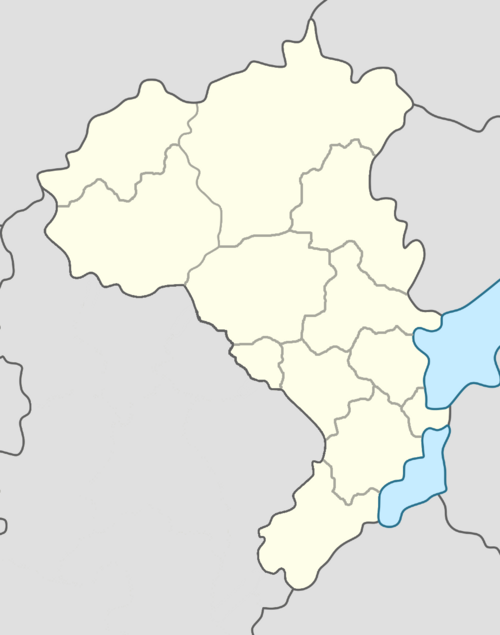East Miersa: Difference between revisions
| Line 215: | Line 215: | ||
As East Miersa embraces the principle of {{wp|national personal autonomy}}, the geographically-organised districts share autonomy with the non-territorial autonomies; associations of persons sharing a common national, ethnic, linguistic or religious identity. The distinction between the districts and the autonomies, aside from the latters' non-territorial nature, is that districts have more autonomy on economic matters, while autonomies have more autonomy on cultural, social, linguistic and religious matters. There are 21 autonomies. | As East Miersa embraces the principle of {{wp|national personal autonomy}}, the geographically-organised districts share autonomy with the non-territorial autonomies; associations of persons sharing a common national, ethnic, linguistic or religious identity. The distinction between the districts and the autonomies, aside from the latters' non-territorial nature, is that districts have more autonomy on economic matters, while autonomies have more autonomy on cultural, social, linguistic and religious matters. There are 21 autonomies. | ||
<div style="display:none;"> | |||
{| class="wikitable" | {| class="wikitable" | ||
| rowspan="13" |{{East Miersa labelled map}} | | rowspan="13" |{{East Miersa labelled map}} | ||
| Line 269: | Line 269: | ||
|- | |- | ||
|} | |} | ||
</div> | |||
===Foreign relations=== | ===Foreign relations=== | ||
Revision as of 19:53, 8 August 2022
This article is incomplete because it is pending further input from participants, or it is a work-in-progress by one author. Please comment on this article's talk page to share your input, comments and questions. Note: To contribute to this article, you may need to seek help from the author(s) of this page. |
Miersan Socialist Federation Mierska federacja socjalistyczna | |
|---|---|
| Motto: "Nie ma wolności bez Solidarności" "There is no freedom without solidarity" | |
| Anthem: La Sobrosienne "The Zobrodzian" | |
| National Cockade | |
 Location of East Miersa (dark green) and claimed but uncontrolled territories (light green) in Euclea. | |
| Capital | Żobrodź |
| Government seat and largest city | Dyńsk |
| Official languages | Miersan |
Recognised minority languages | |
| Ethnic groups (2016) | Miersan (61.6%) Kasavrine (5.4%) Savader (2.2%) Other (4.2%) No answer (26.6%) |
| Religion (2016) | Irreligious (64.2%) Catholicism (27.4%) Episemialism (1.8%) Other (6.6%) |
| Demonym(s) | East Miersan Miersan |
| Government | Federal socialist council republic |
| Iwo Kłosek | |
| Małgorzata Zgorzelska | |
| Legislature | General Congress |
| Formation | |
| 13th century | |
| 17th century | |
| 5 March 1687 | |
| 17 January 1936 | |
• Current constitution | 21 October 1967 |
| Area | |
• Total | 197,568 km2 (76,281 sq mi) |
| Population | |
• 2017 estimate | 21,740,000 |
• Density | 110.04/km2 (285.0/sq mi) |
| GDP (nominal) | 2015 estimate |
• Total | $562.718 billion |
• Per capita | $25,884 |
| Currency | Złoty (zł) (MRZ) |
| Time zone | UTC-1 |
| Internet TLD | .mw |
The Miersan Socialist Federation (Miersan: Mierska federacja socjalistyczna), also known as East Miersa (Miersan: Mierska Wschodnia), is a country in central Euclea. It is bordered by Kantemosha and Kirenia to the north, by Aimilia and Gaullica to the east, and Champania to the south. To the west, it is bordered by West Miersa, though like its western counterpart, East Miersa claims to be the sole legitimate government of the entire Miersan nation. The country has an area of 197,568 km2 (76,281 sq mi) and a population of 21.7 million. The capital city is Żobrodź and the government is seated in Dyńsk, the largest city.
Miersa was first inhabited by the early Marolevs in the late classical period, as the Solarian Empire expanded into the Miersan hinterlands. Although not conquered by Solaria, the Solarians left a definite legacy in the region. Sotirianity was introduced during this period and later embraced when the pagan leaders converted to Solarian Catholicism. The first Miersan states emerged during the Middle Ages, with Wybrzeże as the principal state in the east. They were united in 1257 into one kingdom. The The kingdom would be a pivotal player in central Euclea and included territory as far west as Vedmed and as far south as Champania. Much of its land was religiously and ethnically diverse although political power was rooted in the east of the kingdom. In 1623, the Miersan Interregnum began and subsequently was followed by the and the establishment of the Miersan Republic. The Republic would be short-lived, with the monarchs of Gaullica and Kirenia both claiming the Miersan throne causing the War of the Miersan Succession. By 1638, the kingdom was restored and much of the land in what is now East Miersa was annexed into Gaullica. A second partition followed the end of the Ten Years’ War when Soravia annexed much of the territory in the west and a rump state was left. In 1790, a final partition was performed and the remaining territories were fully annexed between Soravia and Gaullica.
After the Great War, the Miersan Socialist Federation was established in 1936. With support from Kirenia, the East began to recover from the Great War and establish itself as a socialist economy. From the late 1930s to the 1960s, the East began to expand its standard of living and increase the wealth of its population. Power was concentrated around key individuals, who built grassroots power-bases centered around geography, personality, connections, and in some instances bribery. The collapse of Soravia led to the 1980-1981 Miersan War. The East attempted to annex the west but were unprepared for the conflict and after a few months were bogged down. A ceasefire was signed with the East annexing the Ziarnokosz region and crucially the old capital of Żobrodź. The East emerged from the war in a relatively strong position, signifying that they were not merely as client of Kirenia as had been understood by many outside of the socialist world. However, the failure to fully defeat and integrate the west in addition to changing economic circumstances led to a political shift. The east began to move away from “strongman” politics. Politics became non-partisan, with coalitions forming around various causes, mostly centered around ideology, approach, and personality. Organized, national political clubs, organizing groups, and mass organizations are among the leading political entities, however, this system is fairly informal compared to party politics in the past and in many other countries.
Today, East Miersa is a federal constitutionally socialist council republic, operating a socialist economy, with a nominal GDP per capita of $25,884. The current President of the Presidium is Iwo Kłosek. East Miersa is often considered a middle power in central Euclea, maintaining close ties to Kirenia. East Miersa is a member of the Community of Nations, the ITO, the OMS, the Mutual Assistance Organisation and AIS. It is an observer of the ASN.
Etymology
Miersa is an Estmerish translation of the endonym Mierska, which is believed to be derived from the name of a tribe. The name of the tribe is believed to translate to peaceful tribe, as the term Mier(a) means peaceful in Ambrazkan, and the name bears similarities to the Proto-Rutto-Marolevic meiˀras, which stands for peace.
The dominant view in academia is because unlike other Marolevic tribes, the Miersans did not leave the Miersan Basin, which was seen by most historians and anthropologists as the original Marolevic homeland. By this view, the Miersans were peaceful because they did not conquer other lands, unlike other Marolevic tribes. However, a prominent dissenting view was that because Miersans saw themselves as less prone to dynastic and civil conflict than other Marolevs, they saw their domains as the "land of peace."
History
Early history
Having been on the outskirts of the Solarian Empire the region of Miersa during antiquity was made up of a mixture of Tenic, Solarian, Marolevic and Ruttish tribes. By the 1st century the Marolevs became dominant and began to centralize into petty kingdoms. The Miersans were the dominant group being Catholic Marolevs.
Three Crowns
The three first significant Miersan states were known as the Three Crowns. The leading kingdom in East Miersa was Wybrzeże, which was later united with Zachódnia and Firencja by Romuald the Bold in 1257.
Kingdom
The The kingdom would be a pivotal player in central Euclea expanding into modern day Vedmed, Kirenia, Gaullica and Champania. Much of its land was religiously and ethnically diverse although political power was rooted in the east of the kingdom.
Disestablishment and foreign rule
In 1623 the king died without issue, leading to the Miersan Interregnum and the rise of the Miersan Republic. The Republic would be short-lived, with the monarchs of Gaullica and Kirenia both claiming the Miersan throne causing the War of the Miersan Succession. The war ended in 1638 put an end to the Interregnum, with a kingdom being recreated. Land in what is now East Miersa was annexed into Gaullica. The Gaullicans began to expand influence and annex more territory, establishing a strong presence. This resulted in the Miersan elite becoming Soraviophilic.
The end of the Ten Years’ War would lead to a second partition. Soravia annexed much of the territory in the west and a rump state was left. In 1790, a final partition during the Euclean Revolutionary Wars was performed. On the pretense of preventing a republic revolution in Miersa was fully annexed between Soravia and Gaullica. The remaining eastern regions of the rump state were fully annexed into Gaullica. During the period of the final partition the east under Gaullican rule would industrialize while the west remained undeveloped and agricultural. Pan-Marolevic efforts in the west were frustrated by the Catholic faith of the Miersans whilst in the east ethnic differences between Gaullicans and Miersans would end any attempt of a pan-Catholic identity.
Great War
The Great War resulted in the end of Gaullican rule over East Miersa and gave way to socialist partisans, who established control over much of the region with the support of Kirenia. Mass expulsion and persecution of local Gaullicans, including targeted killings. These insurgents also established a presence in Soravian administered lands in the west. West Miersa being perhaps the most devastated area in Euclea as the main battleground between Soravia and Gaullica. In 1935 there were more bullets than there were loaves of bread. Famine, disease outbreaks, looting, socialist insurgents armed to the teeth, and a complete breakdown in law and order pervaded the west. A unified Miersan republic was planned but the strength of socialist partisans would force the imposition of the Godfredson Plan which divided Miersa between a socialist east and authoritarian west.
Post-war history
Power was concentrated around key individuals, who built grassroots power-bases centered around geography, personality, connections, and in some instances bribery. The defining figure during this period was Stanisław Jabłoński, who served as President of the Presidium and First Secretary of the Miersan Working People’s Party (Ludowa Partia Pracy) from 1938 to 1962. He dominated politics in the east and held significant power. He faced little serious opposition during his tenure and has at times been classified as an autocrat. He stepped aside due to health challenges, creating a power vacuum that the east’s grassroots oriented political system struggled to fill immediately. In 1967, Bolesław Rakowski established himself as the central personality in the east’s politics. The east continued to develop, though faced some economic stagnation in the 1970s. Rakowski stepped away in 1978 after a series of corruption scandals shook confidence in his leadership.
1981 to present
Geography
Climate
Environment
Government and politics
President of the Presidium
Executive Secretary
East Miersa is a constitutionally socialist state. It is a federal council republic. It is comprised of districts (powiat) which are further divided into communes (komuna). Each commune is jointly administered by the council of residents' delegates (rada delegatów rezydentów) and the ouncil of workers' delegates (rady delegatów robotniczych). Members of the residents' council are elected by those who live in a commune. These bodies are responsible for local administration. Members of the workers' council are elected by those who work in a commune. Workers' councils ensure that the rights and interests of workers are respected by the residents' council. Members of local councils are elected to the districts, which serve as an electoral college for the national legislature: the General Congress. Since the 1990s, politics in East Miersa is officially non-partisan, and political parties are prohibited by law. Despite this, a level of factionalism remains present, and some politicians organize as part of separate political organizations. The single most influential group in the General Congress is the Mierisan Trade Union Congress. Generally, politics is split along policy lines, with Miersan reunification and intervention in the economy acting as defining issues.
Unlike in liberal democracies, there is no Seyresian separation of powers in East Miersa. Instead, standing committees of the General Congress and the General Congress itself fulfill these roles. The President of the Presidium tends to be incredibly influential in East Miersan politics. The president generally acts as a primus inter pares among the Presidium, which is the collective head of state and serves as the council of ministers. The President of the Presidium is the chairperson of the Executive Committee of the General Congress, which oversees the state bureaucracy. The Presidium consists of the other chairs of the standing committees. Committee chairs also effectively serve as government ministers and lead government departments. The Executive Secretary, on the other hand, acts as a leading voice within the General Congress, fulfilling a similar role to speakers in parliamentary systems.
Legislature
As a council republic, the chief legislature of East Miersa is the General Congress. It has 450 members that are drawn from the residents' councils and workers' councils of each commune. Members of the General Congress are elected through indirect elections. They are elected by members of each district council, electoral college for members of the General Congress for each district. Each district is given an equal number of representatives for the workers' councils and residents' councils. Members of the General Congress are bound by an imperative mandate to the council which elected them, meaning that they can be recalled. Recalls are rare, but not unheard of, and requires a two-thirds majority vote from the nominating council. The General Congress is unicameral.
Since East Miersa does not have Seyresian separation of powers, much power is officially vested in the General Congress and its standing committees. There are 12 standing committees and 24 sub-committees. Committee chairs serve as members of the Presidium. Committee chairs have significant authority over the direction of their committee and the government agencies they oversee, as they act as de-facto government ministers.
Members of the General Congress are required by law, since the Rose Revolution, to be non-partisan, and not be members of any political party. Political parties are banned from organizing in relation to the election of candidates or the procedure of the Congress. Despite this, a number of factions and political clubs are known to operate within the General Congress, but unlike in party systems, these groups are highly informal and are not able to whip votes among members. The most influence of which is the Free Congress of Miersan Trade Unions (WKMZZ), as all workers in Miersa are required to join a trade union affiliated with the body. The General Congress is at times seen as a rubber stamp institution for the WKMZZ.
The General Congress is scheduled to meet four times a year. It convenes for three week sessions in January, April, July, and October. Special sessions can also be called and this is becoming increasingly common. The General Congress is considered to be a slow-moving body due to its consensus-building nature and infrequent sessions. This means that it can take long periods of time for legislation to pass.
Administrative divisions
East Miersa is constituted as a federal council republic, and is constituted by 12 federal units known as districts, which each have a considerable degree of autonomy. The districts are the joint highest-level subdivision within the republic. Beneath the districts are two other territorial units; the obszars and the communes. The obszars constitute larger regions, while the communes are equivalent to parishes or municipalities, with urban (gród) and rural (ziemia) variants. In some cases, the obszars and communes are merged; the autonomous cities are an example of this.
As East Miersa embraces the principle of national personal autonomy, the geographically-organised districts share autonomy with the non-territorial autonomies; associations of persons sharing a common national, ethnic, linguistic or religious identity. The distinction between the districts and the autonomies, aside from the latters' non-territorial nature, is that districts have more autonomy on economic matters, while autonomies have more autonomy on cultural, social, linguistic and religious matters. There are 21 autonomies.
Foreign relations
East Miersa is often considered a middle power with significant influence in central Euclea. East Miersa is closely aligned with Kirenia, and the two countries share an amicable relationship. East Miersa is a founding member of the Association for International Socialism, and is considered a key backer of Intercon. As a constitutionally socialist state, internationalism is an important factor in East Miersan foreign policy, along with the achievement of global socialism. Alongside Kirenia and Aimilia, East Miersa is a founding member of the Mutual Assistance Organisation free trade area and collective security agreement.
East Miersa shares a strony rivalry with West Miersa, stemming from the partition which created the two countries under the Godfredson Plan. This rivalry resulted in open warfare in 1979, with the Miersan War remaining an influential event in regional foreign relations. The Treaty of San Alessandro signed between the two states in 1982 began a long process of normalisation between the two Miersas, who now share limited diplomatic relations. The rivalry persists, but attempts at reconciliation and detente have been made from both sides, and the two states increasingly send joint teams to international competitions. Relations continue to flare up, and the West Miersan government continues to covet the disputed region of Ziarnokosz, which has been occupied by East Miersa since 1980.
East Miersa has been a member of the Community of Nations since 1936, the International Council for Democracy since 1957 and the International Trade Organization since 1996. It is a member of the Organisation of Marolevic States and an observer of the Association of Solarian Nations.
East Miersa has a complicated relationship with Lemovicia. While the East Miersan government has officially recognised the independence of Lemovicia from the western administration, it has not officially renounced the East Miersan claim to the region. It asserts that Lemovicia is constitutionally part of the Miersan nation, in a current state of "unratified and unconfirmed union" within East. In reality, however, the East Miersan and Lemovician governments share close ties, due to shared enmity with the west, and East Miersa is seen as a key backer of the separatist Lemovician state.
Military
East Miersa maintains a strong standing army and armed forces in the form of the People's Protection Forces. The primary objective of the East Miersan military is to act as a defensive force against a potential West Miersan invasion, and in comparison to the west, East Miersa has a much smaller but far more technologically superior force. An important component of the East Miersan defence strategy is the collective security arrangement with Kirenia.
The East Miersan government spends 2.6% of gross domestic product on defence, surpassing the MASSOR minimum. East Miersa abolished conscription in 1992, and all branches of the armed forces are open to all healthy applicants over the age of 16 regardless of gender, nationality or sexual orientation.
Land forces are organised into the People's Revolutionary Army, which maintains an estimated 150,000 active troops. The PRA also contains Exceptional Circumstances, the elite special forces component of the East Miersan military. The People's Revolutionary Airforce has an active troop count of 50,000, while the People's Naval Guard exists as a small lake-bound navy, the primary objective of which is to defend Dyńsk from possible incursions from the east. The Homeland Defence Corps is the primary reservist force, while the People's Civil Defence Corps performs a similar role to a gendarmerie.
Law
Economics
Trade unions
The Free Congress of Miersan Trade Unions (Wolny Kongres Mierska Związków Zawodowych)
Demographics
| Historical population | ||
|---|---|---|
| Year | Pop. | ±% |
| 1936 | 18,764,000 | — |
| 1944 | 19,730,000 | +5.1% |
| 1956 | 20,191,000 | +2.3% |
| 1969 | 20,900,000 | +3.5% |
| 1982 | 21,124,000 | +1.1% |
| 1998 | 21,428,000 | +1.4% |
| 2010 | 21,629,000 | +0.9% |
| 2017 | 21,740,000 | +0.5% |
| Source: Godfredson Plan estimate (1936); CN estimates (1944-present) | ||







